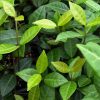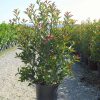The term “summer” and “winter” for squash are only based on current usage, not on actuality. “Summer” types are on the market all winter; and “winter” types are on the markets in the late summer and fall, as well as winter. Thus, the terms “summer” and “winter” are deceptive and confusing. This terminology was never meant to confuse— it just dates back to a time when the seasons were more crucial to man’s survival than they are now. “Good keepers” became known as winter vegetables if they would “keep” until December. Winter squash comes in shapes round and elongated, scalloped and pear-shaped with flesh that ranges from golden-yellow to brilliant orange. Most winter squashes are vine-type plants whose fruits are harvested when fully mature. They take longer to mature than summer squash (3 months or more) and are best harvested once the cool weather of fall sets in. They can be stored for months in a cool basement-hence the name “winter” squash. Stay away from pumpkin pumpkins, whether they’re the classic field type or the original French variety. Carve them, but don’t eat them: they’re tough and bland. Winter squash have hard, thick skins. Store in a cool, dark, well-ventilated place for up to one month. Winter squash can be cut in halves or pieces. Too cook them, first remove fibers and seeds; then bake, steam, or boil the squash. When water is used in cooking, the quantity of water should be kept small to avoid losing flavor and nutrients. Acorn and butternut squash are frequently cut in half, baked, and served in the shell. Squash pulp is also used for pies and may be prepared in casseroles, souffles, pancakes, and custards.
Kakai Squash
Striped fruits and delicious ‘hull-less pumpkin nuts’. Eye-catching, medium-small avg. 5-8 lb., black-striped pumpkins. After displaying the pumpkins, you can scoop out the large, dark green, completely hull-less seed, when roasted are delicious.
Lakota Squash
A Unique Heirloom that traces its ancestry back to the Lakota Sioux Nation. A Sweet, Fine-grained, nutty, orange fleshed Winter Squash. Ready to harvest 85 days after seeding. Wait 100 days to harvest for winter storage. Plant in full sun after all danger of frost is past. Gather mature squash before frost, leaving several inches of stem attached For long term storage. Store in a cool dry place 45-55 degrees.
Peanut Squash
This spectacular squash is pink with beige bumps, that resemble peanuts, covering its surface making this pumpkin-like squash truly unique.
Acorn Squash
Acorn squash are one of the winter squashes that are quite plentiful in the autumn. They range in color from the common dark green to yellow-orange, with combinations as in this one. The flavor of all of them seems to be the same. Select acorn squash that are firm and free of damage or signs of spoilage.
Hubbard Squash
110 days. You can’t mistake a hubbard. They are large, irregularly shaped, blue/gray squash covered in bumpy ‘warts’. The yellow flesh is very moist and the extra hard skins help them keep for long periods, up to 6 months. skin 12 – 15 inches long and 10 – 15 lbs.
Carnival Squash
Isn’t it attractive?!? The best part is that it tastes as good as it looks. It will store for several months and still maintains excellent eating quality. The flavor is somewhere between an Acorn and Delicata.
La Estrella Squash
A new Rupp exclusive tropical pumpkin hybrid from the University of Florida. Bred by Dr. Don Maynard for uniform fruit size and superior flesh color. When grown in the norther states, La Estrella produces 10 pound fruit in 125 days. When it is grown in Florida in the winter, La Estrella produces 6 pound fruit in 70 days.
Triway Squash
This rare squash is three-lobed, with a beautiful blue gray color. The flesh is very thick, an excellent quality for pies or as a vegetable squash. Very appealing for fall displays
Turks Cap Squash
A beautiful squash striped in red, orange, green and white. A very old variety from France (pre-1820) fine thick orange flesh, good sized fruit. Unique.



